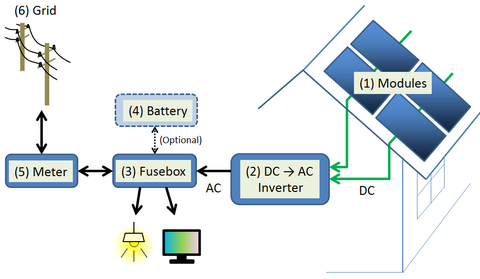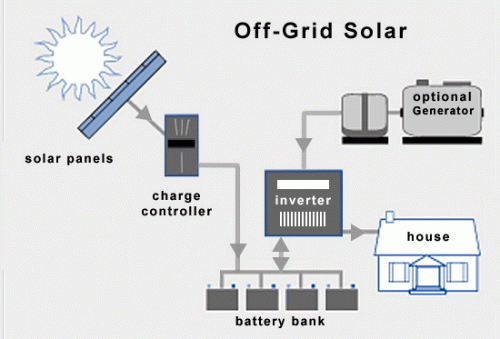
Solar photovoltaic systems
Energy from the sun
The sun has produced energy for billions of years and is the ultimate source for all of the energy sources and fuels that we use today. People have used the sun’s rays (solar radiation) for thousands of years for warmth and to dry meat, fruit, and grains. Over time, people developed technologies to collect solar energy for heat and to convert it into electricity.
Collecting and using solar thermal (heat) energy
An example of an early solar energy collection device is the solar oven (a box for collecting and absorbing sunlight). In the 1830s, British astronomer John Herschel used a solar oven to cook food during an expedition to Africa. People now use many different technologies for collecting and converting solar radiation into useful heat energy for a variety of purposes.
We use solar thermal energy systems to heat:
- Water for use in homes, buildings, or swimming pools
- The inside of homes, greenhouses, and other buildings
- Fluids to high temperatures in solar thermal power plants
Solar photovoltaic systems convert sunlight into electricity
Solar photovoltaic (PV) devices, or solar cells, change sunlight directly into electricity. Small PV cells can power calculators, watches, and other small electronic devices. Arrangements of many solar cells in PV panels and arrangements of multiple PV panels in PV arrays can produce electricity for an entire house. Some PV power plants have large arrays that cover many acres to produce electricity for thousands of homes.

Solar energy has benefits and some limitations
Using solar energy has two main benefits:
- Solar energy systems do not produce air pollutants or carbon dioxide.
- Solar energy systems on buildings have minimal effects on the environment.
Solar energy also has some limitations:
- The amount of sunlight that arrives at the earth’s surface is not constant. The amount of sunlight varies depending on location, time of day, season of the year, and weather conditions.
The amount of sunlight reaching a square foot of the earth’s surface is relatively small, so a large surface area is necessary to absorb or collect a useful amount of energy.|

Energy from the sun
The sun has produced energy for billions of years and is the ultimate source for all of the energy sources and fuels that we use today. People have used the sun’s rays (solar radiation) for thousands of years for warmth and to dry meat, fruit, and grains. Over time, people developed technologies to collect solar energy for heat and to convert it into electricity.
Collecting and using solar thermal (heat) energy
An example of an early solar energy collection device is the solar oven (a box for collecting and absorbing sunlight). In the 1830s, British astronomer John Herschel used a solar oven to cook food during an expedition to Africa. People now use many different technologies for collecting and converting solar radiation into useful heat energy for a variety of purposes.
We use solar thermal energy systems to heat:
- Water for use in homes, buildings, or swimming pools
- The inside of homes, greenhouses, and other buildings
- Fluids to high temperatures in solar thermal power plants
Solar photovoltaic systems convert sunlight into electricity
Solar photovoltaic (PV) devices, or solar cells, change sunlight directly into electricity. Small PV cells can power calculators, watches, and other small electronic devices. Arrangements of many solar cells in PV panels and arrangements of multiple PV panels in PV arrays can produce electricity for an entire house. Some PV power plants have large arrays that cover many acres to produce electricity for thousands of homes.

Solar energy has benefits and some limitations
Using solar energy has two main benefits:
- Solar energy systems do not produce air pollutants or carbon dioxide.
- Solar energy systems on buildings have minimal effects on the environment.
Solar energy also has some limitations:
- The amount of sunlight that arrives at the earth’s surface is not constant. The amount of sunlight varies depending on location, time of day, season of the year, and weather conditions.
The amount of sunlight reaching a square foot of the earth’s surface is relatively small, so a large surface area is necessary to absorb or collect a useful amount of energy.|





